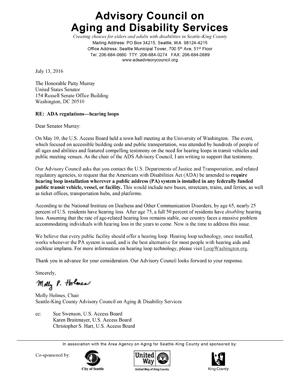Like Wi-Fi for Hearing Aids, Hearing Loops Are Needed Everywhere
 Last month, the ADS Advisory Council sent a message to Senator Patty Murray—the Americans with Disabilities Act (ADA) should be amended to require hearing loop installation wherever a public address (PA) system is installed in any federally funded public transit vehicle, vessel, or facility. In fact, we believe that hearing loops should be installed in any venue where there is a PA system—public or private. And by “public,” let me be clear—every city, county, state, and federal entity and any quasi-governmental body and nonprofit organization that receives public funds should install a hearing loop any place that they install a PA system.
Last month, the ADS Advisory Council sent a message to Senator Patty Murray—the Americans with Disabilities Act (ADA) should be amended to require hearing loop installation wherever a public address (PA) system is installed in any federally funded public transit vehicle, vessel, or facility. In fact, we believe that hearing loops should be installed in any venue where there is a PA system—public or private. And by “public,” let me be clear—every city, county, state, and federal entity and any quasi-governmental body and nonprofit organization that receives public funds should install a hearing loop any place that they install a PA system.
Last month, we published an article about the hearing loop now installed at the Seattle Repertory Theatre. Kudos to The Rep, and to the following venues that have also installed hearing loops—Bellevue Youth Theatre, Everett Performing Arts Center, Taproot Theatre, and Town Hall Seattle.
We would love to see every live performance venue or movie theatre, airport, college auditorium or lecture hall, store, courtroom, place of worship, reception area, senior center, ticket booth, bank window, pharmacy, and common area—you name it, if it has a PA system—follow suit.
Hearing loops should be almost as common as Wi-Fi. In “How hearing loops can help” (Washington Post, 2012), writer Stefanie Weiss likened hearing loops to Wi-Fi for hearing aids: “Just as Wi-Fi connects people to the Web in wired places, hearing loops—simple wires that circle a room or part of a room—can connect many hearing aids and cochlear implants directly to sound systems. Bypassing ambient noise, this wireless connection lets users clearly hear actors on stage, the person in the subway information booth, their ministers or rabbis, announcements at an airport, even their own television sets.”
The Post article points out many public venues in Washington, DC that were looped four or more years ago, including the U.S. House of Representatives chamber and hearing rooms. In our area, elected bodies are starting to come on board. The Seattle City Council looped their chamber at Seattle City Hall in 2015. The Bellevue City Council looped their chamber and conference room earlier this year.
What difference does it make?
Here’s how Village Theatre puts it: “The Everett Performing Arts Center is equipped with a hearing loop system that is compatible with most hearing aids with a T-coil, providing crystal-clear, customized sound directly to your personal device.” Crystal-clear, customized sound can quite literally mean music to the ears of an individual who is hard of hearing.
Hearing loop technology is relative simple and still relatively unknown in our area, so hearing aid wearers may not be familiar with it. We’ve seen jaws drop on the faces of some who have doubted the potential benefits.
How will I know if hearing loop technology is used?
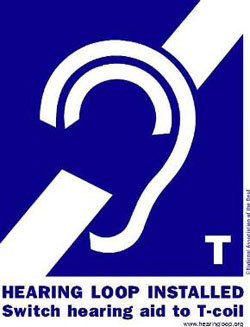 Venues that have installed hearing loops are encouraged to post a blue and white international symbol for assisted listening systems that include a “T” and may include instructions to switch hearing aids to their T-coil settings. For most people who wear hearing aids, this requires only a flick of a switch or push of a button. Anyone who needs information specific to their device should consult their audiologist.
Venues that have installed hearing loops are encouraged to post a blue and white international symbol for assisted listening systems that include a “T” and may include instructions to switch hearing aids to their T-coil settings. For most people who wear hearing aids, this requires only a flick of a switch or push of a button. Anyone who needs information specific to their device should consult their audiologist.
Also, it’s important to note that hearing loops are on whenever a PA system is in use. No specialized equipment is required, other than a personal hearing aid with a T-coil. No arrangements need to be made in advance, once you know a venue has installed a hearing loop. And no one can tell that you’re using the system—so much nicer than wearing headphones or a neckloop receiver!
Community advocacy makes a difference
I want to thank ADS Advisory Council member Mary Anderson for bringing information about hearing loops to our attention several years ago. Mary has said she was inspired by a long-time mentor, PSARA activist Will Parry, who participated in public meetings even when he couldn’t hear well. What a difference a hearing loop would have made!
Diana Thompson, vice-chair of the Bellevue Network on Aging, has also championed hearing loops and other assistive technologies that support individuals with hearing loss.
We are also kept informed by Cheri Perazzoli, founder of Loop Seattle (now Loop Washington) and advocacy director of the Hearing Loss Association of America, Washington Chapter and Karen Utter, chapter president.
The Northwest Universal Design Council, which was born out of the Advisory Council’s commitment to accessibility issues, has also promoted hearing loops and other assistive technologies. For more information, visit www.environmentsforall.org and “Like” them on Facebook.
Join us
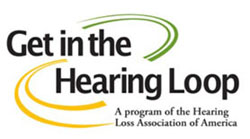 Please join us in advocating for individuals with hearing loss. As our letter to Senator Murray points out, by age 65, nearly 25 percent of U.S. residents have hearing loss. After age 75, a full 50 percent of residents have disabling hearing loss. Truly, since we all know someone with hearing loss, it already affects every one of us.
Please join us in advocating for individuals with hearing loss. As our letter to Senator Murray points out, by age 65, nearly 25 percent of U.S. residents have hearing loss. After age 75, a full 50 percent of residents have disabling hearing loss. Truly, since we all know someone with hearing loss, it already affects every one of us.
Please help us get the word out to elected officials, organization directors, business owners, community leaders, and others that now is the time to address hearing loss. For a list of hearing loop manufacturers and installers, click here.
Related AgeWise King County articles
- Seattle Council Chamber Upgrades Mean More People Can Participate (November 2014), by Seattle City Clerk Monica Martinez Simmons
- Too Many People with Hearing Loss Miss Out (November 2013), by Cheri Perazzoli, vice-president of HLAA-WA and founder of Let’s Loop Seattle
- Universal Design Goes Beyond the Home (March 2012), by ADS planning manager Andrea Yip
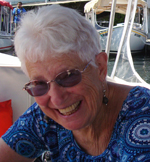 Contributor Molly Holmes is the chair of the Seattle-King County Advisory Council on Aging & Disability Services, which publishes AgeWise King County. Molly welcomes input from readers via e-mail (advisorychair@agewisekingcounty.org) as well as applicants for open positions on the council. For more information, visit www.agingkingcounty.org/advisory-council.
Contributor Molly Holmes is the chair of the Seattle-King County Advisory Council on Aging & Disability Services, which publishes AgeWise King County. Molly welcomes input from readers via e-mail (advisorychair@agewisekingcounty.org) as well as applicants for open positions on the council. For more information, visit www.agingkingcounty.org/advisory-council.
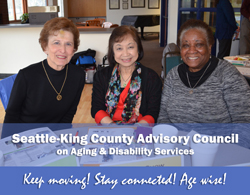 The Seattle-King County Advisory Council on Aging & Disability Services meets monthly, except January and October.
The Seattle-King County Advisory Council on Aging & Disability Services meets monthly, except January and October.
- Listening Session: Your Age-Friendly Future—August 12 forum in north Seattle
- Washington Senior Lobby Conference (October)
- Committees
For information on joining the Advisory Council, visit our How to Join webpage or contact Aging and Disability Services planner Gigi Meinig at 206-684-0652 or gigi.meinig@seattle.gov.
![AgeWise King County [logo]](https://www.agewisekingcounty.org/wp-content/themes/agewisekingcounty/images/logo.png)
